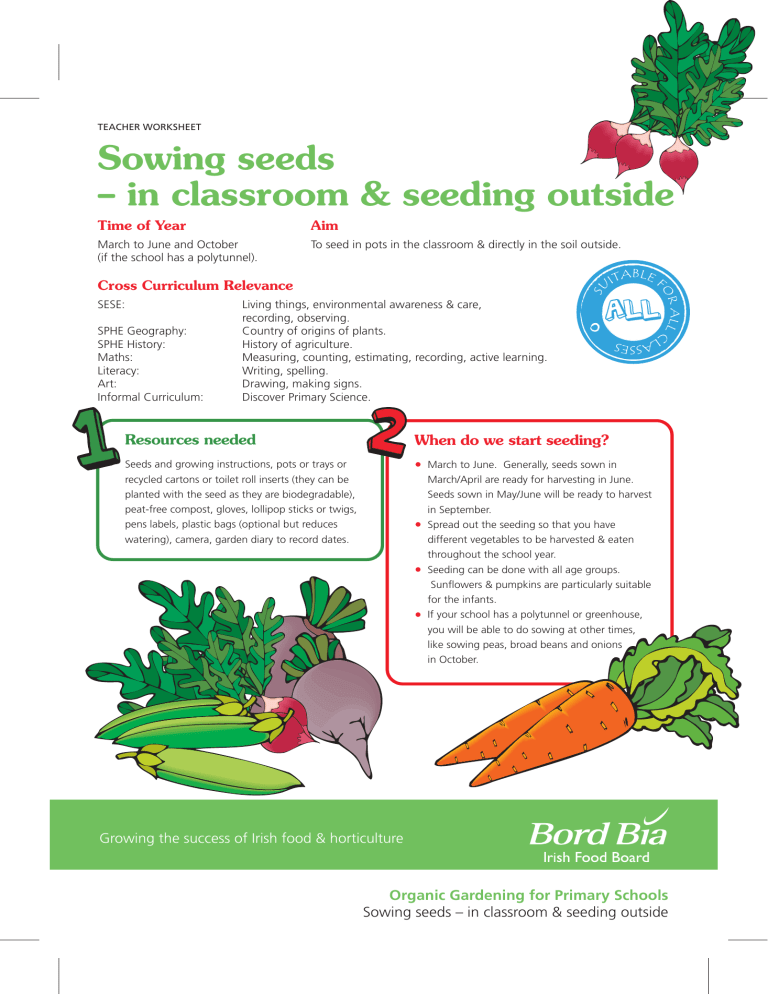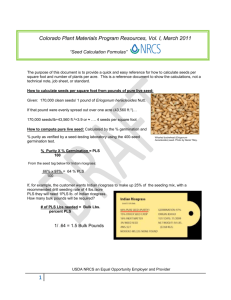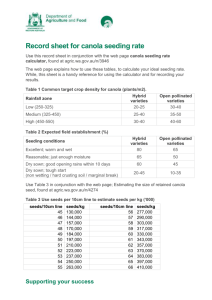Sowing seeds – in classroom & seeding outside

TEACHER WORKSHEET
Sowing seeds
– in classroom & seeding outside
Time of Year
March to June and October
(if the school has a polytunnel).
Aim
To seed in pots in the classroom & directly in the soil outside.
Cross Curriculum Relevance
SESE: Living things, environmental awareness & care,
SPHE Geography:
SPHE History:
Maths:
Literacy:
Art:
Informal Curriculum:
Country of origins of plants.
History of agriculture.
Measuring, counting, estimating, recording, active learning.
Writing, spelling.
Drawing, making signs.
Discover Primary Science.
SU
ITABLE FO
All
ES
ASS
CL
A
R
LL
Resources needed
Seeds and growing instructions, pots or trays or recycled cartons or toilet roll inserts (they can be planted with the seed as they are biodegradable), peat-free compost, gloves, lollipop sticks or twigs, pens labels, plastic bags (optional but reduces watering), camera, garden diary to record dates.
When do we start seeding?
• March to June. Generally, seeds sown in
• March/April are ready for harvesting in June.
• Seeds sown in May/June will be ready to harvest
• in September.
• Spread out the seeding so that you have
• different vegetables to be harvested & eaten
• throughout the school year.
• Seeding can be done with all age groups.
• Sunflowers & pumpkins are particularly suitable
• for the infants.
• If your school has a polytunnel or greenhouse,
• you will be able to do sowing at other times,
• like sowing peas, broad beans and onions
• in October.
Growing the success of Irish food & horticulture
Organic Gardening for Primary Schools
Sowing seeds – in classroom & seeding outside
TEACHER WORKSHEET
Sowing Seeds
Quick and easy seeding projects – Indoors
Health & Safety
Stay with your group. Use tools safely. Wash hands after garden session.
Please refer to the worksheet on Health & Safety for detailed information.
What would be suitable for seeding indoors?
• Peas (sow March to June, also October in
• tunnel, ready to harvest in 10 weeks).
• Sunflowers (sow in March to May).
• Pumpkins (sow April to June, ready to harvest
• in 24 weeks).
• Tomatoes (sow February to March, ready to
• harvest in 20 weeks).
• Spinach (sow March to August, ready to harvest
• in 7-14 weeks).
• Mixed salads & lettuces (sow March to July,
• ready in 6-12 weeks).
How do we seed in pots indoors?
• Buy a variety of seeds (and ask parents to send
• in any surplus seeds).
• Follow the instructions on the seed packet or
• research a book or internet.
• Fill pots or trays with compost.
• Water the compost – add more compost if it
• drops down in the pot.
• Sprinkle the seeds into your hand. Make sure
• your hands are clean & dry.
• If the seed is big (sunflower or pea) plant one to
• a pot.
• If the seeds are small (lettuce or spinach),
• sprinkle a few on the compost.
• Cover the seeds with dry compost – the packet
• instructions will tell you how deep to bury them
• but the general rule is if they are bigger seeds
• they are normally buried deeper.
• Do not water from the top – if the seeds are
• small they will float to the top and could be
• washed away.
• Label the pot or tray with the name of the seed,
• the variety and the date.
• Cover the pots or trays with a plastic bag until
• they germinate (this reduces watering as the
• condensation keeps them moist and warm).
• In a warm class they will sprout quickly
• – check them every day.
• When they germinate remove the plastic bag •
• immediately or they will get ‘leggy’ and are
• more likely to die.
• Water the pots or trays from below. Place pots
• or trays in the sink or a bowl filled with some
• water, until the compost is moist.
• Start ‘hardening off’ the plants in May. If you do
• not have a cold-frame, then bring them outside
• in the daytime and bring them back in before
• school closes everyday for at least a week.
• Planting out instructions is covered in the •
• Planting Out worksheet.
Growing the success of Irish food & horticulture
Organic Gardening for Primary Schools
Sowing Seeds – in classroom & seeding outside
TEACHER WORKSHEET
Sowing Seeds
Quick and easy seeding projects – Outdoors
Health & Safety
Stay with your group. Use tools safely. Wash hands after garden session.
Please refer to the worksheet on Health & Safety for detailed information.
What would be suitable for direct seeding outdoors?
• Radishes (March to September, ready in
• 4-6 weeks).
• Beetroot (sow March to July, ready to harvest
• in 12 weeks).
• Carrots (sow February to July, ready in 12 weeks).
• Spring onions (sow march to May & August to
• September, harvest in 12 weeks).
• Peas (sow March to June, ready to harvest in
• 10 weeks).
• Leeks (sow January to April, ready to harvest in
• 32 weeks; over-wintering crop).
• grains (varies according to the grain – can be
• sown in spring or autumn).
How do we direct seed outdoors?
• Follow the instructions on the seed packet or
• research a book or internet.
• Cultivate and prepare the soil as required, e.g.
• carrots like sandy soil and do not like manure.
• If the soil is dry, water it before seeding – if you
• water after seeding they will float to the surface
• and be washed away.
• Mark the rows with lollipop sticks or twigs.
• If you are seeding carrots or beetroot – make a
• shallow trench with a trowel.
• If you are sowing a bigger seed make a hole with
• your finger or the handle of the trowel.
• Sprinkle the seeds into your hand. Make sure
• your hands are clean & dry.
• Then sprinkle them into the trench or hole.
• Cover the seeds back with soil to the depth on
• the seed packet and make labels for the rows.
• Seed sown outdoors should need less watering
• – check them regularly.
Other resources
Organic Vegetable Planner Wheel
– available from www.ecotopia.co.uk
Research Words:
COLD-FRAME
HARDENING OFF
DAMPING-OFF
Growing the success of Irish food & horticulture
Organic Gardening for Primary Schools
Sowing Seeds – in classroom & seeding outside









